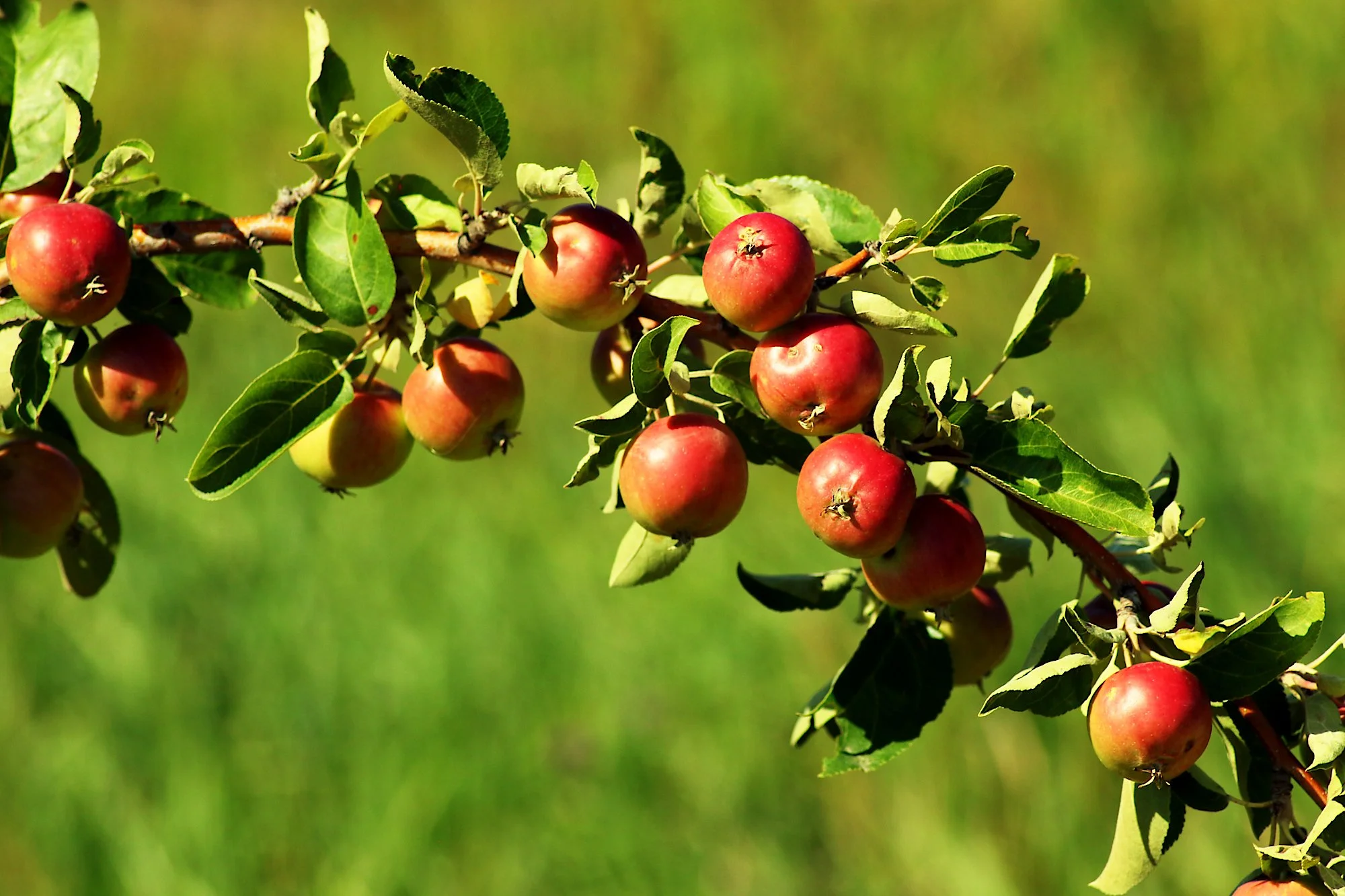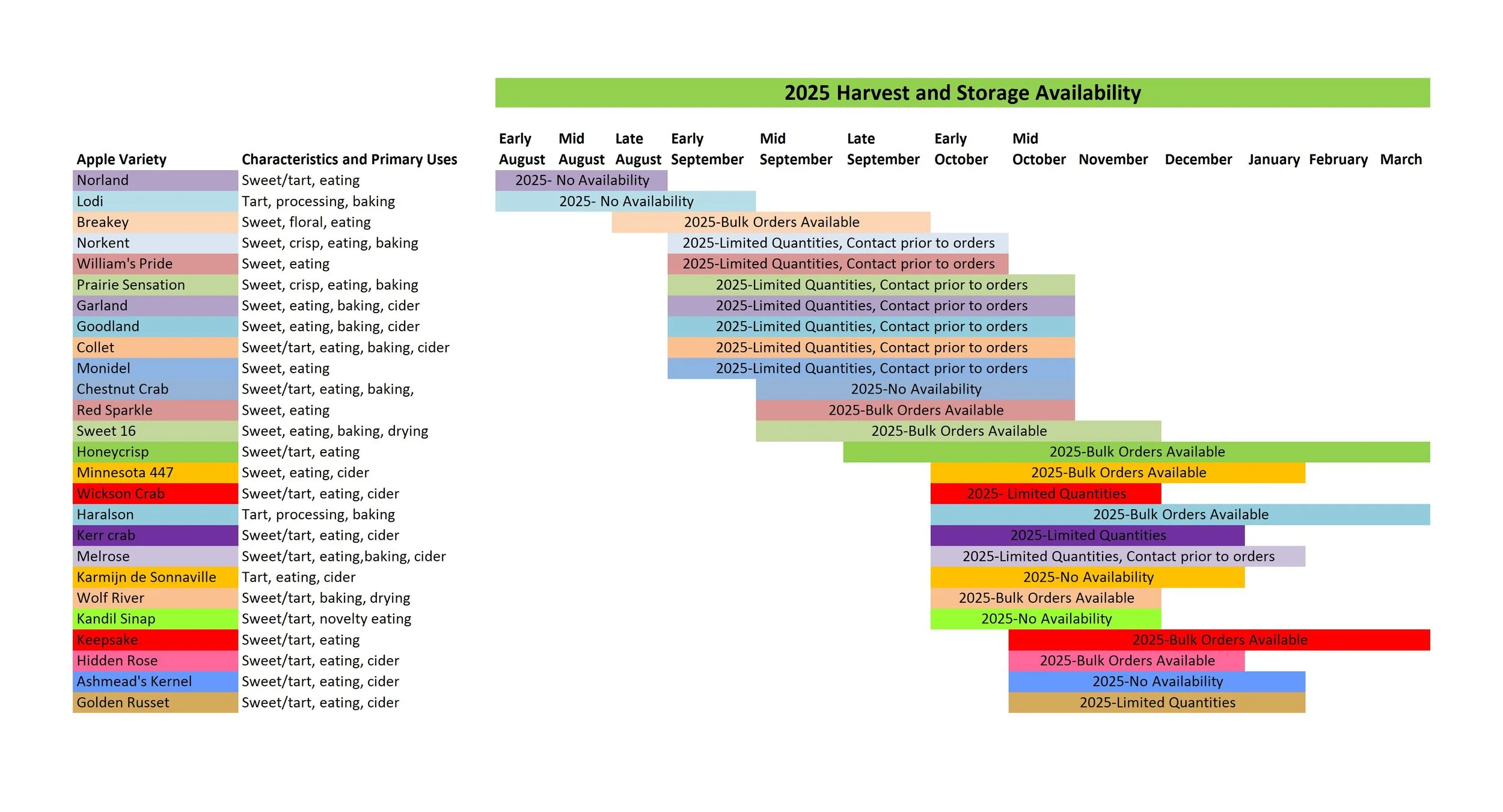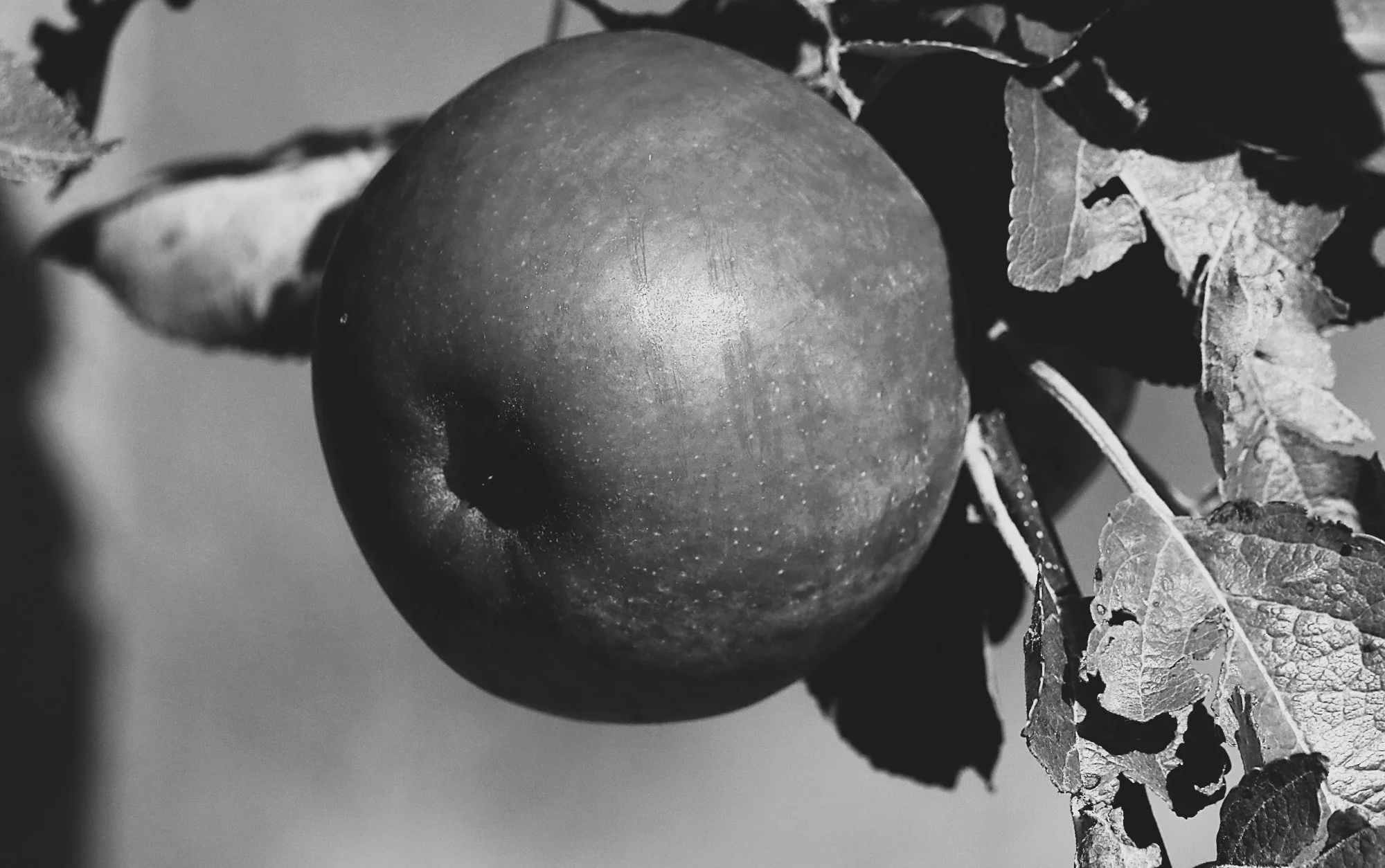
2025 Apple Variety Availability and Descriptions
Our Apple Varieties
Breakey
Origin: Open Pollinated “Blushed Caville”, bred Agricultural Research Station, Morden MB, released 1935
Appearance, Flavour, and Texture: Fragrant, floral, with spicy notes, lightly crisp melting flesh.
Use and Limitations: Tasty and refreshing for fresh eating, also excellent for baking, sauces and jellies. Browns slightly when cut, fruit tends to drop when ripe.
Peak Season: Ready at end of August/beginning of September, keeps in cold storage for 8 weeks.
Williams Pride
Origin: Bred by Purdue/Rutgers/Illinois State University Breeding Programs, released in 1988 as a disease resistant variety with Melba, Red Rome Beauty, Jonathan, Wealthy, Mimi, and July Red in the parental lineage.
Appearance, Flavour, and Texture: Attractive medium to large dark purple/red apple with light lenticles, similar in appearance to Cosmic Crisp, but darker. Excellent fresh eating apple with a complex, spritely flavour, and overtones of concord grape.
Use and Limitations: All purpose, and very popular with our kids, but still uncertain of hardiness of tree for Manitoba. We have planted more trees but will need to continue to evaluate.
Peak Season: Ready in early September, keeps in refrigerator for 4-6 weeks.
Prairie Sensation
Origin: Morden 359 X Brookland, bred at University of Saskatchewan, released 2005.
Appearance, Flavour, and Texture: Medium to large, lobsided, yellow washed with red striping, with fine grained, crisp and breaking flesh, lightly acidic, and aromatic with hints of bubble gum flavour!
Use and Limitations: Excellent for fresh eating, and general all purpose.
Peak Season: Ready in early September, keeps in cold storage for 8-12 weeks.
Goodland
Origin: Open Pollinated “Patten” seedling, bred at Agriculture Research Station, Morden MB, released 1948
Appearance, Flavour, and Texture: Round, red striped, juice, tender fleshed with tangerine overtones when fully tree ripened.
Use and Limitations: Excellent eating in late September, softens by late October, delicious flavour in baking and ciders.
Peak Season: Ready in early September, keeps in cold storage for 6-8 weeks.
Collet
Origin: Open pollinated Seedling from seeds collected at Morden Research Station. First grown at Notre Dame-de-Lourdes MB, by V.C. Collet. Released 1948.
Appearance, Flavour, and Texture: Fragrant, round, medium sized, slightly conic. Flavour similar to McIntosh, slightly tart, sprightly and flavourful like a fresh cider. Firm, fine grained flesh.
Use and Limitations: Fresh eating, baking, flavour develops best after frost.
Peak Season: Pick in mid-September, keeps 8-12 weeks in cold storage.
Monidel
Origin: Bred by Georges Delbard in Malicorne France, a “Jonagrimes” x Golden Delicious cross, released in 1974. Also called “Delbarestivale”.
Appearance, Flavour and Texture: Medium to large yellow and red stripped apple, round/conical in shape with a firm, crunchy texture. Lovely sweet/tangy flavour with hints of strawberry, aniseed, and pear.
Use and Limitations: Fresh eating, and all purpose, we only have a few trees and are evaluating our production and trees for hardiness, but have planted a few more because they are delicious!
Peak Season: Ready in early September, keeps in fridge for 8 weeks.
Chestnut Crab
Origin: Malinda X Siberian Crab, bred at University of Minnesota, released 1946
Appearance, Flavour, and Texture: Small round apple, around the size of a clementine or mandarin orange, bronzed skin washed with red and lightly russeted. Intense peach/pear/honeyed flavour, with nut and vanilla overtones, some taste Coca Cola? Fine grained, crunchy, juicy flesh.
Use and Limitations: An eating apple of apple connoisseurs, also excellent in jelly, as well as fresh and hard ciders. Goes soft by early October.
Peak Season: Ready in MB in mid-September, keeps in fridge for 4-5 weeks..
Red Sparkle
Origin: Melba X Trail Crab apple, bred at Agricultural Research Station, Morden MB, released 1990.
Appearance, Flavour, and Texture: Medium sized, green with solid, ruby red wash, with coarse, crisp flesh, lightly acidic and astringent, with distinctive aromatic flavour, perhaps nectarine and lychee overtones?
Use and Limitations: Excellent for fresh eating, and excellent in fresh and hard ciders. Softer but still pleasant in late-October.
Peak Season: Ready by mid-September, keeps in fridge for 8 weeks.
Garland
Origin: Melba X Haralson, bred at Agricultural Research Station, Morden MB, released 1961
Appearance, Flavour, and Texture: Medium to large, deep red, McIntosh style, coarse flesh, juicy and sprightly.
Use and Limitations: Lovely for fresh eating, softens in baking, excellent in fresh cider.
Peak Season: Ready in mid-September, keeps in fridge for 12 weeks.
Sweet Sixteen
Origin: Bred at University of Minnesota. Mn 447 crossed with Northern Spy. An Auntie or Uncle of Honeycrisp.
Appearance, Flavour and Texture: An exceptional fresh eating apple, with a mysterious flavour. Some people taste licorice, or bourbon, or “Cherry Lifesavers”! When at its prime, Sweet Sixteen’s wild taste and juicy, crispy texture cause a lot of surprised smiles!
Use and Limitations: Eating, dried apple rings, baking, sauce, cider. One weakness is a tendency to premature drops. Best before the new year.
Peak Season: Ready by late-September, keeps in fridge up to 3 months.
Haralson
Origin: University of Minnesota, cross of Malinda and Wealthy apples. Released 1922.
Appearance, Flavour and Texture: Medium to large, solid crimson red over yellow skin, with some russeting, positively sour in October, developing a gentler, sweeter flavour in the new year. A firm, crunchy white flesh.
Use and Limitations: Primarily a fresh eating apple, but also excellent when dried, in baking and hard ciders. All around all-star apple for folks who like things on the sour side.
Peak Season: Ready in early October in Manitoba, keeps in fridge for 4-6 months.
Minnesota 447 (Frostbite)
Origin:Open pollinated “Malinda” seedling, bred at University of Minnesota in 1920’s, released as “Frostbite” 2010, but well known as Mn447 prior. Parent of Sweet 16, Keepsake, grandparent of Honeycrisp.
Appearance, Flavour and Texture: Small to medium sized apple, golden yellow with dark red wash and russeting at stem. Very crisp flesh, mildly acidic, and intensely sweet, with mandarin, lychee, and perhaps sugarcane flavours, that keep improving in storage.
Use and Limitations: A fantastic fresh eating apple, also excellent in cider. Significant weakness is tendency to develop cracks at the stem when ripening which can cause spoilage during storage.
Peak Season: Ready at end of beginning of October, keeps crispy in cold storage for 4-6 months if carefully selected (without stem cracks). Should be called a “Christmas Apple”!
Kerr
Origin: Morden Agricultural Research Centre, Manitoba, cross of Haralson Apple and Dolgo Crab Apple. Released 1952.
Appearance, Flavour and Texture: Small, firm apple golf-ball to pool-ball sized, deep purple in colour when ripe. Intense, unmistakable flavour with lots of acidity and sugar. “Nectar of the apple Goddess” is how Manitoba apple pioneer Betty Kehler described them to me! Of course, she was talking about turning them into cider.
Use and Limitations: Awesome for kid school lunches, but primarily used as an award-winning cider apple, both fresh and fermented. Also excellent as an apple jelly. Juice comes out bright pink. One limitation is the tree’s tendency for biennial bearing.
Peak Season: Ready in early October a few days after a good frost, keeps in fridge for 4 months.
Melrose
Origin: Ohio Agricultural Experimental Station, cross of Stark Red Delicious and Jonathan. Released 1944.
Appearance, Flavour and Texture: A medium to large, deep red over greenish yellow apple. Very crisp, creamy white flesh, tangy straight from tree with complex, aromatic flavours developing in storage.
Use and Limitations: Excellent for fresh eating after storage. Reportedly really nice for baking and cider as well. Experimental variety for Manitoba, seems hardy for our orchard but may prove difficult to ripen fully on some years.
Peak Season: First year in production, estimated to be ready in mid-October in Manitoba! Keeps in fridge for 3-4 months.
Hidden Rose
Origin: Found as wild seedling near town of Airlie in state of Oregon. Identified as new variety by pomologist Bill Shultz in 1980. Synonyms include “Hidden Rose”, “Mountain Rose”
Appearance, Flavour and Texture: Small to medium sized yellow green apple with red cheek on sunny side and spotted white lenticels. Has been described as “the worlds crunchiest strawberry” crossed with lemon. Of course, the craziest thing is the colour of the flesh, which is like dragon fruit.
Use and Limitations: Nice for fresh eating, great in salads as it stays hot pink! Great for kid school lunches! Very late ripening is a limitation some years here in Manitoba.
Peak Season: Mid-October in Manitoba, keeps in the fridge for 3 months.
Honeycrisp
Origin: University of Minnesota, seedling of Keepsake, other parent unknown. Released 1991.
Appearance, Flavour and Texture: Medium to large, striped to solid red over green skin, balanced tangy sweet, with a certain refreshing flavour overtone (perhaps like wheatgrass?) and famous crispy texture. Ours tend to be tangier than the store bought ones.
Use and Limitations: Famous for fresh eating. Can be used for baking and lovely in salads. May have issues with potassium/calcium imbalances which can cause a condition called bitter-pit, so a little trickier to grow well.
Peak Season: Ready by late-September in Manitoba, keeps in cold storage for 4-6 months unless afflicted with bitter-pit.
Keepsake
Origin: Bred at University of Minnesota. Mn 447 crossed with Northern Spy. A sibling of Sweet 16 and the parent of Honeycrisp.
Appearance, Flavour and Texture: Another exceptional eating apple, one connoisseur mentions the flavours of pecans, simmered in rosewater, with a touch of lemon, sweet and flowery, a little smaller on average than Honeycrisp, but harder and just as crisp.
Use and Limitations: Fresh eating, baking, cider. Excellent winter “keeper”, with flavour and texture best after at least one month of storage .
Peak Season: Ready by mid-October, keeps in fridge for 6 months.
Wolf River
Origin: Fremont, Wisconsin, found near the Wolf River, most likely a seedling of “Alexander” 1856.
Appearance, Flavour and Texture: Very large, broad, yellow and red stripped apple, with coarse, softer texture. Juicy, aromatic, and tart, with hints of cherry near the skin.
Use and Limitations: Primarily a baking, processing and cider apple, also well known for making excellent dried apple rings. Not as ideal for fresh eating due to softer texture, but passable straight off the tree.
Peak Season: Ready in early October, keeps in fridge for 8 weeks.














